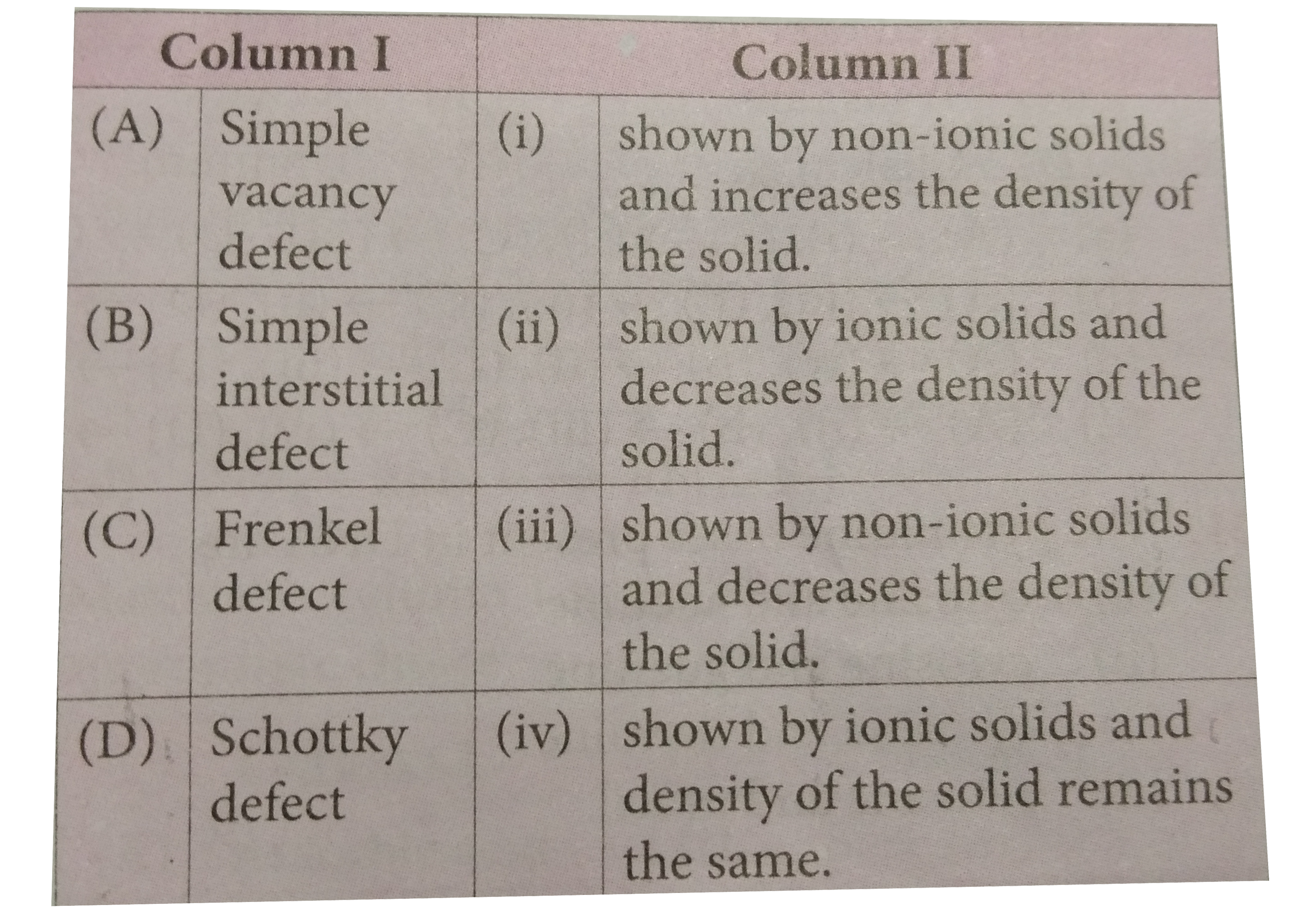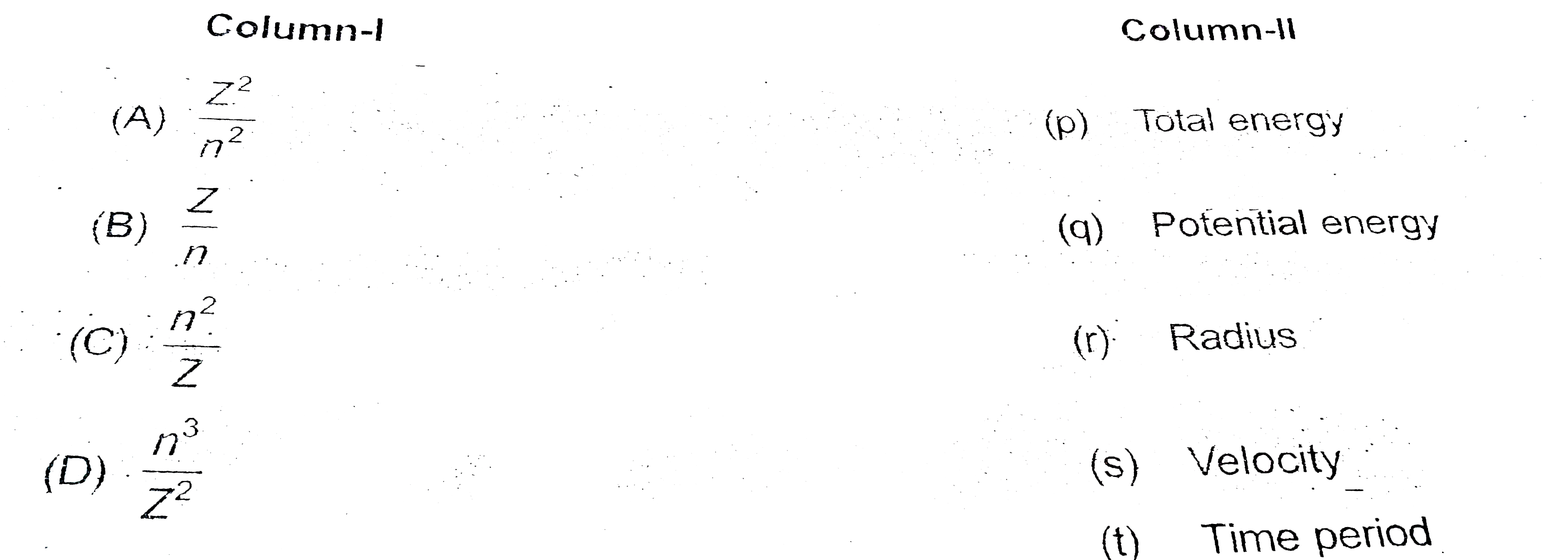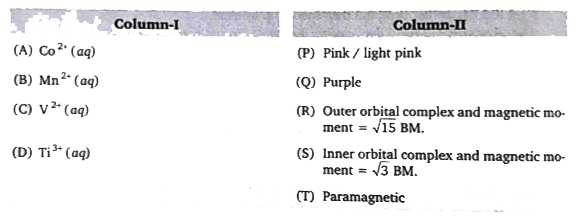Column-1 gives three physical quantities. Select the appropriate units for the choices given in column-II. Some of the physical quantities may have more than one choice.
Column-IColumn-IICapacitanceohm-secondInductanceCoulomb2/JouleMagnetic inductioncoulomb/voltnewton/ampere metrevolt-second/ampere
The correct Answer is:Capacitance →coulomb2/joule & colulomb/volt
Inductance → ohm-second & volt -second/ ampere
To solve the problem of matching physical quantities with their appropriate units, we will analyze each quantity in Column-I and find the corresponding units in Column-II.
1. Capacitance:
- The formula for capacitance (C) is given by:
C=QV
where Q is charge (in coulombs) and V is voltage (in volts).
- Voltage can also be expressed as:
V=WQ
where W is work done (in joules).
- Therefore, substituting for voltage, we have:
C=QWQ=Q2W
- The units of capacitance can be expressed as:
- C=CoulombVolt (Option B)
- C=Coulomb2Joule (Option C)
- Thus, capacitance corresponds to options B and C.
2. Inductance:
- The formula for inductance (L) can be derived from the relationship of electromotive force (emf):
emf=−Ldidt
- Rearranging gives:
L=−emfdidt
- Here, emf is measured in volts, di in amperes, and dt in seconds. Thus:
L=Volt⋅SecondAmpere=Volt-Second/Ampere
- Since Volt/Ampere=Ohm, we can also express:
L=Ohm⋅Second(Option A)
- Therefore, inductance corresponds to options A and A.
3. Magnetic Induction:
- The magnetic induction (B) is defined in terms of force per unit charge:
B=Fq
- In SI units, this can be expressed as:
B=NewtonCoulomb(Option D)
- Additionally, we can express it in terms of other units:
B=NewtonCoulomb⋅1Second=NewtonCoulomb⋅Second=NewtonAmpere⋅Meter(Option D)
- Therefore, magnetic induction corresponds to option D.
Final Matching:
- Capacitance: B, C
- Inductance: A, A
- Magnetic Induction: D
Summary of Answers:
- Capacitance: B, C
- Inductance: A
- Magnetic Induction: D
- The formula for capacitance (C) is given by:
C=QV
where Q is charge (in coulombs) and V is voltage (in volts).
- Voltage can also be expressed as:
V=WQ
where W is work done (in joules).
- Therefore, substituting for voltage, we have:
C=QWQ=Q2W
- The units of capacitance can be expressed as:
- C=CoulombVolt (Option B)
- C=Coulomb2Joule (Option C)
- Thus, capacitance corresponds to options B and C.
- The formula for inductance (L) can be derived from the relationship of electromotive force (emf):
emf=−Ldidt
- Rearranging gives:
L=−emfdidt
- Here, emf is measured in volts, di in amperes, and dt in seconds. Thus:
L=Volt⋅SecondAmpere=Volt-Second/Ampere
- Since Volt/Ampere=Ohm, we can also express:
L=Ohm⋅Second(Option A)
- Therefore, inductance corresponds to options A and A.
- The magnetic induction (B) is defined in terms of force per unit charge:
B=Fq
- In SI units, this can be expressed as:
B=NewtonCoulomb(Option D)
- Additionally, we can express it in terms of other units:
B=NewtonCoulomb⋅1Second=NewtonCoulomb⋅Second=NewtonAmpere⋅Meter(Option D)
- Therefore, magnetic induction corresponds to option D.
- Capacitance: B, C
- Inductance: A, A
- Magnetic Induction: D
- Capacitance: B, C
- Inductance: A
- Magnetic Induction: D
Topper's Solved these Questions
- BOOK - ALLENCHAPTER - MISCELLANEOUSEXERCISE - Exercise-0277videos
MISCELLANEOUS
- BOOK - ALLENCHAPTER - MISCELLANEOUSEXERCISE - Exercise-031videos
MISCELLANEOUS
- BOOK - ALLENCHAPTER - MISCELLANEOUSEXERCISE - EXERCISE-5(A)15videos
MISCELLANEOUS
- BOOK - ALLENCHAPTER - KINEMATICS (MOTION ALONG A STRAIGHT LINE AND MOTION IN A PLANE)EXERCISE - BEGINNER S BOX-78videos
KINEMATICS (MOTION ALONG A STRAIGHT LINE AND MOTION IN A PLANE)
- BOOK - ALLENCHAPTER - PHYSICAL WORLD, UNITS AND DIMENSIONS & ERRORS IN MEASUREMENT EXERCISE - EXERCISE-IV8videos
PHYSICAL WORLD, UNITS AND DIMENSIONS & ERRORS IN MEASUREMENT
Similar Questions
In Column-I, some physical quantities are given and in column-II, dimensions of the physical quantities are given . Match the entries in column-I to each entry in Column-II.
 View Solution
View SolutionName the physical quantities of which the units are :
(i) volt, (ii) coulomb, (iii) ohm, (iv) ampere.View Solution
Knowledge Check
- Question 1 - Select One
Match the defects gives in column I with statements given in column II and mark the appropriate choice.
 AA→iv,B→iii,C→ii,D→iBA→iii,B→iv,C→I,D→iiCA→iii,B→I,C→iv,D→iiDA→I,B→iii,C→iv,D→ii
AA→iv,B→iii,C→ii,D→iBA→iii,B→iv,C→I,D→iiCA→iii,B→I,C→iv,D→iiDA→I,B→iii,C→iv,D→ii
Column-II give some quantities associated with electron of hydrogen like atom. The quantities are proportional to entries given in column-I . Match the column appropriately
 View Solution
View SolutionColumn - II shows the optical phenomenon that can be associated with optical components given in column- I . Note the column - I may have more than one matching options in column-II.
Column IColumn II(A)Convex mirror(p)Dispersion(B)Converging lens(q)Deviation(C)Thin prism(r)Real image of real object(D)Glass slab(s)Virtual images of real objectView SolutionEntries of Column-I are to be matched with entries of Coloumn-II. Each entry of Column-I may have the matching with one or more than one entries of Column-II.
 View Solution
View SolutionEntries of Column-I are to be matched with entries of Coloumn-II. Each entry of Column-I may have the matching with one or more than one entries of Column-II.
 View Solution
View SolutionEntries of Column-I are to be matched with entries of Coloumn-II. Each entry of Column-I may have the matching with one or more than one entries of Column-II.
 View Solution
View SolutionIn column I, certain thermodynamic process are given and in Column II, the value of physical quantities are given. Match the Column I with Column II suitably. (Given: ρ= density of gas)
 View Solution
View SolutionEntries of Column-I are to be matched with entrices of Column-II. Each entry of Column-I may have the matching with one or more than entries of Column-II
 View Solution
View Solution

